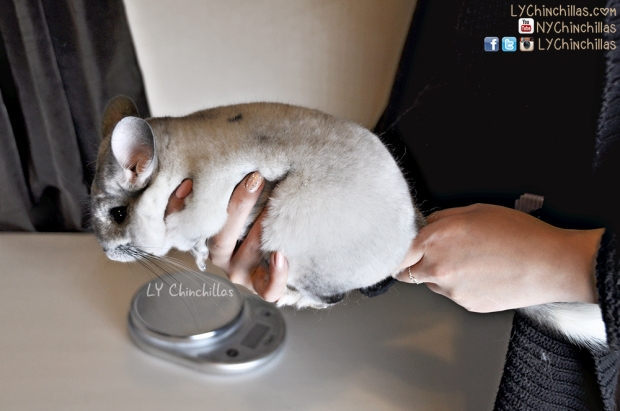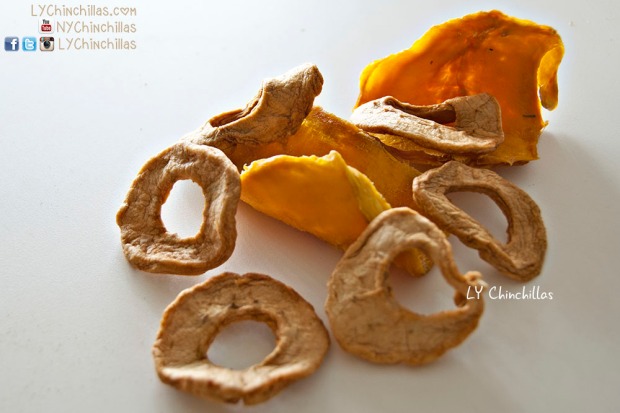An often overlooked aspect of chinchilla ownership is weighing your chinchilla. While it’s not imminently necessary if you have a healthy chinchilla, owners often regret not weighing them once an illness or injury has occurred. Because chinchillas don’t show too many visual cues, weight is a great albeit general way to see how everything is doing with your chin. In addition to weight, behavior, consumption, and digestive output (poop!) are important elements to consistently monitor – they’re major cues to any potential problems.
There are only a few simple steps to successfully weighing your chinchilla.
Buy a Scale: Scales are easy to purchase in stores or online, and relatively inexpensive (around $30). I use a digital kitchen and food scale that weigh items (and chinchillas) up to 10-12 lbs. Most chinchillas weigh under 4 pounds, so these scales are more than adequate for your chin-kids. There are many different styles; some have circular platforms, rectangular, oval, and even curved platforms, which many owners love because of its harder-for-chinchillas-to-escape design. I use an Ozeri brand food scale with a circular surface, and it works well for my round babies.

Be Consistent: It’s important to weigh your chinchilla from time to time in order to utilize the aspect of weight in your chinchilla’s health. Each owner has their own routine: some weigh monthly, weekly, or from time to time when they suspect any health problems. Personally, I try to weigh my chinchillas every day. I feel that the routine helps me bond with my chins and build a level of baseline interaction. Interaction is more important than weight, as it helps you understand any variations in your chinchilla’s behavior (which, if acutely different, should be checked out by an exotic vet). I try and weigh my chinchillas at roughly the same time of the day – although it doesn’t necessarily guarantee consistent results, I try to keep my variables as close to a baseline as possible.

Understand Variation: Due to consumption, time of day, and slightly altering routines, your chin’s weight can fluctuate daily, upwards of 15-20 grams! It’s important to note that weight is only one indicator of many to your chin’s health. Most of the time, any weight lost yesterday will be replaced tomorrow. My rule is, if there are no changes in consumption, poops, or behavior, then I’ll give my chins one week to bring their weight back up before considering further action. If there’s weight loss coupled with a negative change in any of the other three indicators, I’ll give 2-3 days for self-recovery prior to a vet visit. If there’s weight loss coupled with obvious injury or a more acute drop in consumption or behavior, I’ll schedule a visit for the next day. Growth slows over time and chinchillas are considered full-grown around 8-18 months old; prior to then, chins should be gaining weight steadily over time. Once full-grown, chins should be maintaining their weights or slightly increasing with slight variation. For LY Chinchillas, Mittenmaus is leading the way at 835 grams and Koko ties Fifi for last place at 663 grams! Aside from controllable factors like diet and exercise, uncontrollable factors like genetics and age always have something to do with weight; that’s important to remember.

The Weighing Process: You only need your chinchilla to be still for 2-3 seconds on the scale in order to successfully record your data. This process can be quite tough for most people, as chinchillas are skittish and hate standing still! Many owners like to tempt stillness with a safe treat – however, with daily weighing, I’ve opted out of the treat option and learned how to hone the chinchillas without any treats. Like many things with chinchilla ownership, the first step is patience. Of course, you’ll want to set your scale to measure in grams, which is the most common unit of measure for these little guys. After that, get familiar with your scale and keep your weight notebook nearby. At that point, these are my steps:
1. I dust my chinchilla. Because we live in an area of relative humidity and none of my chinchillas have dry skin problems (and love to dust), this is added on to my daily routine. This step disorients them a little, and they’ve just exuded a little bit of energy rolling themselves around and getting dizzy. If you’re not able to dust daily or daily dusting isn’t needed due to your geography and preference, then this step can be skipped.

2. I carefully lift my chinchilla and place him/her on the scale. I handle them either with them willingly standing on my palm to be transported – see Muff above, or being held gently by the torso and base of the tail – see Lulu above. The scale is located 3-4 feet from their cages; minimizing distance traveled helps the process be as seamless as possible. Patience is key here, as after they are oriented, they’ll try to scurry away and jet. I’ll steady the chinchilla, making sure the tail is lifted and not touching the ground (if the tail is resting on a surface, it will take pressure off the scale and the chinchilla will end up weighing 10-20 grams less) and lift my hands away, keeping a sharp eye on the number and the chin. I’ll try this four or five times if the chinchilla is being uncooperative, cupping my hands around the chin until he/she is still and then removing my hands in an attempt for a quick read. If a chin really isn’t in the mood to stay still, I’ll return the unwilling participant to his or her cage and try again later. At this point, since the scale is part of their daily routine, I have minimal problems and it’s a rare day if I have a chin behaving badly.

3. I record their weights. After successful weighing, I won’t have enough time to write their number down. Instead, I’ll memorize the number and place the chinchilla back in their cage, often with a little willow twig or apple stick as a safe chewy reward. After they’re safely in their cage, I’ll write their number down and do a quick comparison. If the number is not showing a steep or steady decline, I’ll continue on the daily routine without worry.

4. I analyze the numbers! Every week or two, I’ll enter these numbers in an Excel spreadsheet and graph the bad boys just for some visual fun! Working with numbers isn’t exactly the most exciting thing, so it’s always rewarding to watch the numbers grow and change over time!

Another method which has been successful for owners (but requires some minimal math or resetting of your scale settings) is to place a container on your scale that more easily confines your chinchilla, then weigh your chinchilla and subtract the weight of the container. This method helps minimize the need to manually contain your chinchilla, although you may need to try this method several times as well, due to any shifting weight or escape attempts. Stillness is key to a successful weighing, and most chins won’t let you succeed too easily! Patience is key to unlocking your chinchilla’s weight, and a can-do attitude never hurts!


LY Chinchillas Treat Donation
Donate healthy, delicious treats to LY Chinchillas to help keep our content going!
$5.00








